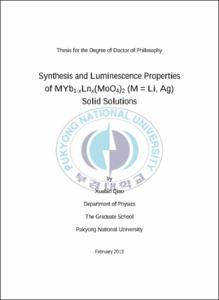Synthesis and Luminescence Properties of MYb1-xLnx(MoO4)2 (M = Li, Ag) Solid Solutions
- Abstract
- MYb1-xLnx(MoO4)2 (M = Li, Ag, x = 0.01-1, Ln = Eu, Tb, Ho) solid solutions were prepared by conventional solid state reaction. A systematic structural of the solid solution series was carried out by X-ray powder diffraction. The typical diffraction peaks reveal a systematic shift to lower angle, confirming the formation of solid solutions. The luminescence characteristics are investigated including downconversion and upconversion of rare earth-doped MYb(MoO4)2 solid solutions, for UV to near-infrared emission and near-infrared to visible upconversion.
The LiYb1-xEux(MoO4)2, AgYb1-xEux(MoO4)2 LiYb1-xTbx(MoO4)2 and LiYb1-xHox(MoO4)2 solid solutions were systematically investigated by means of optical and laser-excitation spectroscopy. It is noticeable that, with increasing Eu3+/Tb3+ concentration, the luminescence intensity increases with no concentration quenching, which indicates that LiYb1-xEux(MoO4)2, AgYb1-xEux(MoO4)2 and LiYb1-xTbx(MoO4)2 can be candidates for high rare earth-concentrated phosphors with high emission efficiency for solid-state lighting applications. For LiYb1-xHox(MoO4)2 solid solutions,the concentration quenching occurs when Ho concentration reaches to 10mol%. The cooperative blue emissions are observed in LiYb1-xEux(MoO4)2 and LiYb1-xTbx(MoO4)2 solid solutions. With increasing Eu- or Tb-concentration, energy transfer occurs between Yb-Eu or Yb-Tb couples.
The Ho3+/Tm3+ co-doped LiYb(MoO4)2 phosphors under the laser excitation at 975 nm shows the bright white upconversion emission composed of a blue emission at 475 nm from Tm3+, and green and red emissions at 545 and 660 nm from Ho3+, respectively. The coordinates of Ho3+/Tm3+ co-doped LiYb(MoO4)2 in the commission international de’eclairage (CIE) chromaticity diagram can be controlled from yellow to blue depending on the Tm3+ and Ho3+ concentrations. In Ho3+/Tm3+ co-doped LiYb(MoO4)2, the upconversion luminescence properties on Tm3+ and Ho3+ concentrations and mechanism based on laser pump power are discussed in detail.
- Issued Date
- 2013
- Awarded Date
- 2013. 2
- Type
- Dissertation
- Publisher
- 부경대학교
- Affiliation
- 부경대학교 대학원
- Department
- 대학원 물리학과
- Advisor
- 서효진
- Table Of Contents
- Content
Abstract xviii
1. Introduction 1
2. Background 3
2.1 The lanthanides 3
2.2 Lanthanide excitation process 8
2.2.1 4f-4f transition 9
2.2.2 4f-5d transition 10
2.2.3 charge-transfer state transition 11
2.3 Lanthanide de-excitation process 12
2.3.1 Radiative transition 12
2.3.2 Non-radiative transition 13
2.4 Energy transfer process 15
2.4.1 Radiative and non-radiative energy transfer 16
2.4.2 How to distinguish between radiative and non-radiative energy transfer 17
2.4.3 Energy transfer probability 17
2.5 Photon upconversion mechanism 20
2.5.1 The excited state absorption upconversion 22
2.5.2 Energy transfer upconversion 23
2.5.3 Photon avalanche upconversion 23
2.5.4 Cooperative luminescence. 23
2.5.5 Cooperative sensitization. 24
2.6 Downconversion 25
3. Sample preparation and experimental measurements 28
3.1 Experimental chemical reagents 28
3.2 Solid state reaction 28
3.3 Sample preparation 30
3.4 X-ray diffraction phase analysis 32
3.5 Photoluminescence spectroscopy 34
3.6 Pulsed laser system 35
3.7 Upconversion photoluminescence measurement under 975 nm laser diode 37
4. Phase formation and structure description 39
4.1 LiYb1-xLnx(MoO4)2 (Ln = Eu, Tb, Ho) 39
4.1.1 Structure description 39
4.1.2 Phase formation 42
4.2 AgYb1-xEux(MoO4)2 48
4.2.1 Structure description 48
4.2.2 Phase formation 49
5. Charge transfer transition, cross relaxation and thermal properties in MYb1-xEux(MoO4)2(M = Li, Ag) 51
5.1 Excitation and emission spectra 51
5.1.1 LiYb1-xEux(MoO4)2 51
5.1.2 AgYb1-xEux(MoO4)2 60
5. 2 Decay curves 76
5.2.1 LiYb1-xEux(MoO4)2 76
5.2.2 AgYb1-xEux(MoO4)2 80
5. 3 Cross relaxation 86
5.3.1 LiYb1-xEux(MoO4)2 86
5.3.2 AgYb1-xEux(MoO4)2 91
5.4 Thermal quenching of luminescence 93
6. Yb3+ emission and upconversion in LiYb1-xLnx(MoO4)2 (Ln = Eu, Tb, Ho) 100
6.1 Yb3+ emission under the UV excitation 101
6.2 Upconversion luminescence 110
6.2.1 Upconversion in LiYb1-xEux(MoO4)2 111
6.2.2 Upconversion in LiYb1-xTbx(MoO4)2 116
6.3 Excitation, emission spectra and decay curves of LiYb1-xTbx(MoO4)2 124
6.3.1 Excitation and emission spectra 124
6.3.2 Decay curves 129
7. Color tuning and white upconversion luminescence 130
7.1 Color tuning in LiYb1-xHox(MoO4)2 130
7.2 LiYb(MoO4)2:Tm3+ 136
7.3 White upconversion in LiYb(MoO4)2:Ho, Tm 138
8. Summary and Conclusions 142
8.1 Phase formation and solid solution 142
8.2 Structure dependent photoluminescence 142
8.3 Infrared emission of Yb3+ and upconversion 144
8.4 Color tuning and white upconversion luminescence 144
References 146
Acknowledgement 154
- Degree
- Doctor
- Files in This Item:
-
-
Download
 Synthesis and Luminescence Properties of MYb1-xLnx(MoO4)2 (M = Li, Ag) Solid Solutions.pdf
기타 데이터 / 6.25 MB / Adobe PDF
Synthesis and Luminescence Properties of MYb1-xLnx(MoO4)2 (M = Li, Ag) Solid Solutions.pdf
기타 데이터 / 6.25 MB / Adobe PDF
-
Items in Repository are protected by copyright, with all rights reserved, unless otherwise indicated.